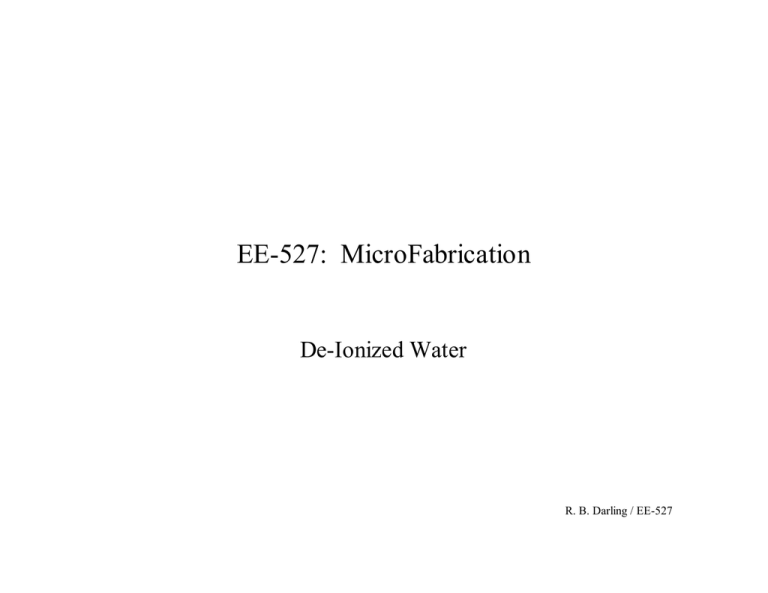EE-527: MicroFabrication De-Ionized Water R. B. Darling / EE-527
advertisement

EE-527: MicroFabrication De-Ionized Water R. B. Darling / EE-527 Clean Water as a Processing Chemical • Water (H2O) is the most prevalently used material in microfabrication processes, and is used mainly for rinsing and cleaning of wafers. • Approximately 6000 gallons of de-ionized (DI) water are required for each 6” CMOS wafer. • DI water must be manufactured on site to achieve the quality and purity levels required by modern microfabrication. • Each gallon of DI water may require as much as 4-6 gallons of raw city grade water to manufacture. • DI water must be continuously recirculated in order to achieve the quality and purity levels. R. B. Darling / EE-527 Size Ranges of Suspended Particles – Macro Particle Range • > 25 µm, visible to the naked eye – Micro Particle Range • 1 - 15 µm, visible with an optical microscope – Macro Molecular Range • 0.1 - 1 µm, visible with a high power optical microscope – Molecular Range • 1 - 100 nm, visible with a scanning electron microscope – Ionic Range • 0.1 - 1 nm, not visible with current technology R. B. Darling / EE-527 Size Range of Common Particles Atomic Radii Metal Ions Aqueous Salts Sugars Pyrogens Collodial Silica Albumin Protein Viruses Carbon Black Tobacco Smoke Paint Pigment Bacteria Lung Damaging Dust Coal Dust Milled Flour Yeast Cells Red Blood Cells Pollens Human Hair (Diameter) Mist Beach Sand 1-6 Angstroms 2-7 Angstroms 2-20 Angstroms 7-25 Angstroms 20-250 Angstroms 6-250 nm 8-100 nm 9-100 nm 12-100 nm 20-1000 nm 0.1-5 µm 0.25-30 µm 0.5-35 µm 1.0-100 µm 1.0-100 µm 2.0-50 µm 5.0-9.0 µm 10-100 µm 25-200 µm 70-200 µm 100-10,000 µm R. B. Darling / EE-527 Types of Water Filtration – Particle Filtration • 1-75 µm cartridge filters: cellulose, fiberglass, or polypropylene fibers – Microfiltration • 0.1-1.0 µm cartridge filters: ceramic or polymer membranes – Ultrafiltration • 20-2000 Angstroms: chemically based – Reverse Osmosis (Hyperfiltration) • 1-200 Angstroms: uses special membrane and high pressure to overcome osmotic pressure R. B. Darling / EE-527 Osmotic Pressure difference in fluid levels is caused by the osmotic pressure pure H2O H2O + dissolved ions Semipermeable membrane allows water to pass, but not dissolved ions. Water flows in a direction so as to aid diffusion and dilute itself as much as possible. This produces the osmotic pressure. R. B. Darling / EE-527 Reverse Osmosis (RO) – By applying a pressure greater than the osmotic pressure, water can be driven backwards through the membrane for purification (reverse osmosis process). – Terminology: • TDS = total dissolved solids • “product” = pure water produced by RO • “concentrate” = rejected water which contains concentrated dissolved material • “recovery” = ratio of product to input water, typically about 75 % • “rejection” = fraction of TDS that is retained by the RO filter membrane, typically about 90-95 % – Rejection and recovery are optimized by RO operating pressure and the type of RO membrane. • Higher pressures increase recovery, but decrease rejection. R. B. Darling / EE-527 Reverse Osmosis (RO) System RO membrane input supply water product pure H2O H2 O + dissolved ions high pressure pump (125-175 psi, typ.) adjustable pressure building valve concentrate R. B. Darling / EE-527 Ultraviolet Sterilizers – Standard is 25 mW-sec @ 253.7 nm; strongest Hg arc line. – This bursts the cell membranes of bacteria and renders their DNA incapable of reproduction. – Exploded remains of bacteria are called “pyrogens” and must be collected by a 0.2 µm filter downstream from the sterilizer. Hg arc lamp at 253.7 nm output R. B. Darling / EE-527 Ion Exchange Columns – Based upon ion exchange resins: • Cation exchangers: H+ ↔ Na+, K+, Ca++, etc. • Anion exchangers: OH- ↔ Cl-, Br-, F-, etc. • Both cation and anion exchange resins are built into a coaxial cartridge assembly. Exchanged H+ and OH- ions combine to form H2O. R. B. Darling / EE-527 Features of DI water systems - 1 • Water must flow continuously through recirculation loops at approximately 10 linear feet per minute to keep bacteria from forming on walls. • Dead-legs must be avoided in plumbing-- stagnant regions will provide culture zone for bacterial growth. • Distance from loop to taps must be minimized. • All piping must be PVDF (teflon) with fusion welded joints. • No metal parts must be in contact with loop, except for a few stainless steel parts around the UV sterilization units which are unavoidable. • Let DI faucets run until resistivity monitor reads > 18 MΩ -cm. • High usage during day may require make-up system to run overnight to replenish supply in recirculation tank. • If system “goes green” it must be sterilized with H2O2 and then restarted. H2O2 is reduced to H2O and O2 upon passing through UV sterilizer. (Turn the UV unit off for system sterilization.) R. B. Darling / EE-527 Features of DI water systems - 2 • Because of its zero ion and mineral content, DI water is a powerful leaching agent for metals. Metals in contact with DI water are often eroded in very short periods of time. Metal pump impellers last only a few months if they are not teflon coated. • Molecular chlorine (Cl2) and chloride ion (Cl-) are removed differently from incoming water. – Cl- is removed via the ion exchange columns – Cl2 is removed via an activated carbon filter – Cl2 must be removed prior to the RO, or it will destroy the membrane • Final polishing is performed with 0.2 µm filters. • Breach of an upstream filter often sends particles and debris down stream in sufficient quantity to damage subsequent filters. • Change cartridge filters when the pressure difference across them exceeds more than about 10 psi. R. B. Darling / EE-527 Integrated Circuit Processing Requirements Mass Production Started Wafer Size (mm) DRAM Technology 2 Chip Size (cm ) Feature Size (µm) Process Steps Cleanroom Class 1980 75 64K 0.3 2.0 100 1,000-100 1984 100 256K 0.4 1.5 150 100 1987 125 1M 0.5 1.0 200 10 1990 150 4M 0.9 0.8 300 1 1993 200 16M 1.4 0.5 400 0.1 1996 200 64M 2.0 0.35 500 0.1 Utility Purity (ppb) 1,000 500 100 50 5 1 1999 200 256M 3.0 0.25 600 0.1 mini environment 0.1 2004 300 1G 4.5 0.2-0.1 700-800 0.1 mini environment 0.01 Data from Chang and Sze, ULSI Technology. R. B. Darling / EE-527 Water Purity Measures – Resistivity (ρ), measured in MΩ -cm • Perfectly pure water at 20ºC has ρ = 18.2 MΩ -cm • Perfectly pure water at 20ºC has pH = 7.00 – Total Organic Carbon (TOC), measured in ppm – Total Dissolved Oxygen (TDO), measured in ppm • Pure water in equilibrium with air has TDO of around 20 ppm, depending upon agitation conditions – Total Heavy Metals (THM), measured in ppm – Bacteria, measured in colony forming units (CFU) per liter per day R. B. Darling / EE-527 ASTM D-1193-91 Type 1 Reagent Water – Specifications: • • • • • ρ > 18 MΩ -cm TOC < 100 ppb Na+ < 1 ppb Cl- < 1 ppb Silica < 3 ppb – Basic de-ionized water available at taps in EE MicroFab Lab. – De-ionization is different from distillation!! • De-ionization removes charged ionic species, not neutral molecules. • Distillation removes molecules of differing vapor pressure, such as alcohols and other solvents, but does not de-ionize. • Distillation is more commonly used in biological applications. R. B. Darling / EE-527 SEMI recommended DRAM1 pure water guidelines • • • • • • ρ > 18.2 MΩ -cm TOC < 5 ppb THM < 1 ppb TDO < 20 ppm < 200 particles 0.3-0.5 µm/L < 1 particle > 0.5 µm/L Semiconductor Equipment and Materials International (SEMI) is a standards organization for the microelectronics industry Max ions (ppb) Max metals (ppb) Na+ 0.05 Li 0.03 B 0.05 K+ 0.1 Na 0.05 Al 0.05 Cl- 0.05 K 0.05 Mn 0.02 Br- 0.1 Mg 0.02 Fe 0.10 NO3- 0.1 Ca 2.00 Ni 0.02 SO4- 0.1 Sr 0.01 Cu 0.02 total 0.5 Ba 0.01 Zn 0.02 Pb 0.05 R. B. Darling / EE-527


